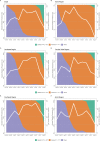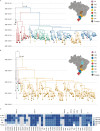Emergence and Spread of the SARS-CoV-2 Variant of Concern Delta across Different Brazilian Regions
- PMID: 36000897
- PMCID: PMC9604183
- DOI: 10.1128/spectrum.02641-21
Emergence and Spread of the SARS-CoV-2 Variant of Concern Delta across Different Brazilian Regions
Abstract
The SARS-CoV-2 variant of concern (VOC) Delta was first detected in India in October 2020. The first imported cases of the Delta variant in Brazil were identified in April 2021 in the southern region, followed by more cases in different regions during the following months. By early September 2021, Delta was already the dominant variant in the southeastern (87%), southern (73%), and northeastern (52%) Brazilian regions. This study aimed to understand the spatiotemporal dissemination dynamics of Delta in Brazil. To this end, we employed a combination of maximum likelihood (ML) and Bayesian methods to reconstruct the evolutionary relationship of 2,264 VOC Delta complete genomes (482 from this study) recovered across 21 of the 27 Brazilian federal units. Our phylogeographic analyses identified three major transmission clusters of Delta in Brazil. The clade BR-I (n = 1,560) arose in Rio de Janeiro in late April 2021 and was the major cluster behind the dissemination of the VOC Delta in the southeastern, northeastern, northern, and central-western regions. The AY.101 lineage (n = 207) that arose in the Paraná state in late April 2021 and aggregated the largest fraction of sampled genomes from the southern region. Lastly, the AY.46.3 lineage emerged in Brazil in the São Paulo state in early June 2021 and remained mostly restricted to this state. In the rapid turnover of viral variants characteristic of the SARS-CoV-2 pandemic, Brazilian regions seem to occupy different stages of an increasing prevalence of the VOC Delta in their epidemic profiles. This process demands continuous genomic and epidemiological surveillance toward identifying and mitigating new introductions, limiting their dissemination, and preventing the establishment of more significant outbreaks in a population already heavily affected by the COVID-19 pandemic. IMPORTANCE Amid the SARS-CoV-2 continuously changing epidemic profile, this study details the space-time dynamics of the emergence of the Delta lineage across Brazilian territories, pointing out its multiple introductions in the country and its most prevalent sublineages. Some of these sublineages have their emergence, alongside their genomic composition and geographic distribution, detailed here for the first time. A special focus is given to the emergence process of Delta outside the country's south and southeast regions, the most populated and subjects of most published SARS-CoV-2 studies in Brazil. In summary, the study allows a better comprehension of the evolution process of a SARS-CoV-2 lineage that would be associated with a significant recrudescence of the pandemic in Brazil.
Keywords: B.1.617.2; Brazil; COVID-19; Delta; SARS-CoV-2; variant of concern.
Conflict of interest statement
The authors declare no conflict of interest.
Figures



References
-
- WHO. 2021. Tracking SARS-CoV-2 variants. https://www.who.int/en/activities/tracking-SARS-CoV-2-variants/. Accessed 20 June 2022.
-
- GISAID. EpiCoV Database. https://www.epicov.org/epi3/frontend#4b8e1e. Accessed 6 June 2022.
-
- ECDC. 2021. Threat assessment brief: emergence of SARS-CoV-2 B.1.617 variants in India and situation in the EU/EEA. https://www.ecdc.europa.eu/en/publications-data/threat-assessment-emerge.... Accessed 6 June 2022.
-
- Li Q, Wu J, Nie J, Zhang L, Hao H, Liu S, Zhao C, Zhang Q, Liu H, Nie L, Qin H, Wang M, Lu Q, Li X, Sun Q, Liu J, Zhang L, Li X, Huang W, Wang Y. 2020. The impact of mutations in SARS-CoV-2 spike on viral infectivity and antigenicity. Cell 182:1284–1294.e9. doi:10.1016/j.cell.2020.07.012. - DOI - PMC - PubMed
Publication types
MeSH terms
Supplementary concepts
LinkOut - more resources
Full Text Sources
Medical
Miscellaneous

